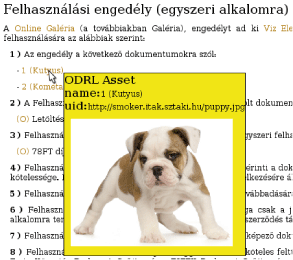by Mihály Héder and Balázs Rátai
Carneades Contract Format (CCF) is a flexible and extensible representation framework for legal contracts. This new format makes it possible to represent equally the text, document structure and semantics of legally binding agreements. The concept was developed by Carneades Consulting and the Internet Technology Department of SZTAKI, which also played an important role in the selection of the optimal technical solution and developed the first demo implementation.
The majority of Web applications require the user's consent to various types of contract before access to their services can be granted. A typical example of such a contract is a 'terms of use' document. Online commercial transactions also result in contractual relationships (eg sales contracts in the case of Web shops).
The current practice of online contract management has many shortcomings, the most significant of which are the following: (i) agreements appear in the form of long and complex text documents that cannot be processed with machines; (ii) overwhelmingly general contractual terms and conditions are used; and (iii) the transaction-specific contractual information is stored separately in databases.

One of the reasons for this situation is the lack of a generic standard for the representation of legally binding agreements that is simple and flexible enough to store the text of the agreement, the document structure and the related semantic data in the same document. The CCF intends to be just such a format. Instead of producing a rich semantic expression set or a data dictionary for a specific field, we have been focusing on the structure of the document. Having examined the everyday practice of legal procedures and the requirements of lawyers, we found that there is a strong need for electronic legal documents which are usable as documentary evidence in legal procedures. For this to be possible, all the relevant information should be stored in the same place (ie not distributed in different databases, transaction logs and legal texts about the general conditions of use), should be in a format readable by lay users (so that experts are not needed to interpret it), and the document should be provably authentic (ie it should be signed). Ideally, documentary evidence should be very easy to present to the court. Our aim is to develop a format specifically to meet these criteria. To the best of our knowledge, this is a completely new approach to developing a legal format.
In order to help to overcome the above-mentioned shortcomings of present practice, we have defined the following design goals:
- the format must be as simple as possible
- the format should capture only the structure of a contract document, allowing the user to choose the semantic vocabulary (ie ODRL Data dictionary elements or XACML expressions) of the annotation, thus allowing a wide range of existing legal semantic markup formats to be used
- the documents in this format must be readable with a common Web browser
- it should be possible to embed the documents using the format into existing Web pages in order to allow the development of interoperable Web solutions.
In order to meet the above requirements, a relatively simple XML schema was defined that describes the entire contract as a hierarchy of conditions and sub-conditions, references and annexes. The result is a CCF document that is capable of structuring the text of the contract into a simple, hierarchical form. It allows further annotation of the text with existing, sophisticated, application-specific formats such as Open Digital Rights Language (ODRL) or eXtensible Access Control Markup Language (XACML).
The next step is to embed the whole document into another XML file, which contains an Extensible Stylesheet Language Transformation (XSLT) document. The result is a document that, when opened by a Web browser, is a compound structure of XHTML+CSS+Javascript elements. This kind of bundling of data and representation is a novel solution for legal contracts. The flexible structure of the document also allows an enveloped XML Digital Signature to be added.
A document created this way unifies the advantages of accessible Web documents and the expression power of the application-specific legal formats, which are capable of representing legally relevant and easily processed semantic information about the text.
As mentioned above, it is possible to embed, anywhere in the document, valid XML from any namespace (eg ODRL or XACML) in so-called extension elements.
By default, the semantic annotations in the document become simple visual annotations in the browser. If there are parts of the XSLT prepared to handle the particular namespace used in an extension element, the visual representation becomes even more informative.
A special kind of annotation is the contract modification, which we have placed in a different namespace. Using the elements of this namespace, we can produce contracts which modify other contracts. Using the original contract and the modifications we can always derive the current, consolidated view of the original and the modifying contract. On a technical level, however, the modification schema is just like an external schema to the contract, such as XACML, ODRL or others.

There are many possible applications of the format. Just to mention a few, it is possible to (i) derive access control decisions directly from XACML-annotated usage agreements; (ii) provide a summary of an annotated document; (iii) implement smart searching in documents based on semantics; and (iv) provide an overview of many contracts or generate statistics based on large number of annotated documents.
We are currently testing and evaluating our solution in the framework of a research project called AAI-Based Authorization Broker, an e-commerce solution based on strong identity and policy management. This is a sub-project of the Mobile Innovation Centre, a research and development program sponsored by the Hungarian government, in the area of mobile telecommunication.
Links:
AAI project: http://www.sztaki.hu/search/projects/project_information/?uid=00210
CCF schema: http://www.carneades.hu/xml/carneadescontract
Please contact:
Mihály Héder
SZTAKI, Hungary
Tel: +36 1 279 6027
E-mail: mihaly.heder![]() sztaki.hu
sztaki.hu
Balázs Rátai
Carneades Consulting, Hungary
Tel: +36 1 394 2114
E-mail: balazs.ratai![]() carneades.hu
carneades.hu










